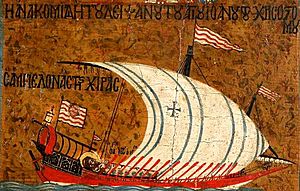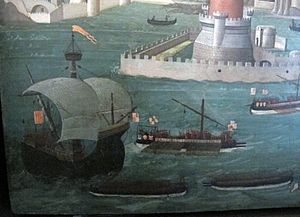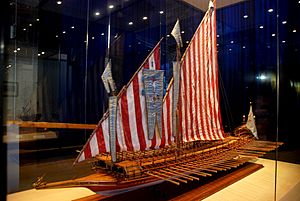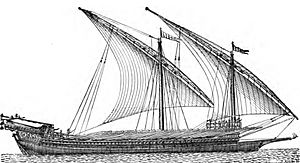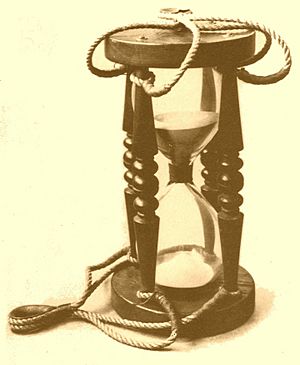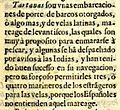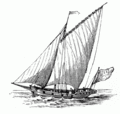Catalan navy facts for kids
The Catalan navy was a powerful force in the Mediterranean Sea for many centuries. It included ships, admirals, and sailors from Catalonia, a region in Spain. These ships often followed the orders of the Counts of Barcelona, who were important leaders. Even later, ships built and crewed in Catalonia served other kings, like those of Naples, and took part in big events.
The navies of the kingdoms of Mallorca and Valencia were also important and had their own unique strengths.
Contents
People often call it the "Navy of the King of Aragon," but that's not quite right for medieval times. Before King Ferdinand the Catholic, the galleys (a type of ship) from the Crown of Aragon usually belonged to Catalonia, Valencia, or Mallorca. They were often owned by local groups like the Generalitat (a government body) or cities. Sometimes, private citizens owned them. These ships would serve the king, but he didn't always own them directly.
For a long time, the Catalan navy was very well-known and respected.
- Benedetto Cotrugli, a writer from the 1400s, said that Catalan people were especially good at sailing and managing galleys. He wrote that other nations only prepared their ships when needed, but Catalans were always practicing and knew everything about sailing.
- Martí de Viciana, another historian, noted that Catalans had achieved more great things with galleys than any other nation. This led to a saying: "If something good happens on a galley, the captain must be Catalan."
The Book of the Consulate of the Sea
The "Book of the Consulate of the Sea" was a very important collection of laws and rules for sailing and trade in the Mediterranean. It had a special section called "Ordinations of all Ships who will arm themselves to go to choirs, and of all navies that are faciper sea." This part gave detailed instructions for how ships should be run.
It explained the jobs and duties of everyone on a ship, from the admiral and captain to the sailors, pilots, and even the barber! It also covered how profits and expenses should be shared. For example, it talked about:
- The admiral, captain, and ship owners.
- The comitre (a ship officer).
- Pilots and other crew members.
- Crossbowmen and soldiers.
- Gabieros (sailors who worked high up on the mast).
- Helmsmen (who steer the ship).
- Barbers (who also often acted as doctors).
- Carpenters and other skilled workers.
Another important part of the book was the "Penal Ordinances for the service of the Navy." These were 39 rules about crimes and actions at sea. King Peter ordered these rules in Barcelona in 1430. They were created by three famous Catalan sailors: Bernat de Cabrera, Jaume Boscà, and Joan Llompart.
Catalan Galleys: Fast and Strong Ships
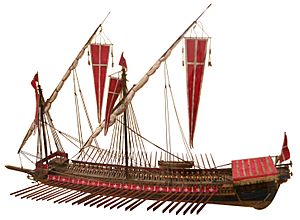
The Catalan galley was a special type of ship, different from those of other nations. Records show "Catalan galleys" existed as early as 1120, which is about 100 years before similar ships were mentioned in other countries. These ships were used for both war and trade. They were mainly powered by rows of oars, but they also had masts and sails (usually triangular Latin sails) to use the wind when possible.
From the 12th century onwards, Catalans built and used these galleys a lot. They fought wars with other powerful cities and countries, sometimes as enemies and sometimes as allies. They also used galleys for trading with most Mediterranean ports, helping to keep trade routes safe. Catalan consulates (offices that helped traders) were set up in many places. The use of galleys started to decrease in the 1600s as sailboats became more common. By the late 1700s, galleys were no longer used.
When sailors explored the Atlantic Ocean, they needed tools like the compass, tables, astrolabes, and quadrants. But even with these, much of the distance traveled was figured out by "dead-reckoning." This means estimating your position based on your speed, direction, and how long you've been traveling. To do this, you needed a way to measure time accurately.
The Marine Sandglass
For over 500 years (from about 1300 to 1800), the main tool for measuring time at sea was the "ampoule of hours," or sandglass. In Catalonia, these sandglasses were made from the mid-1300s using clear Catalan glass. This glass was made with a special soda from a plant called barrella, which grew along the Catalan coast. Even Italian glassmaking manuals said, "you need to buy soda from Spain" because it was so good.
In 1380, an inventory of items owned by Charles V of France mentioned an "orloge de mer" (sea clock) or "heures de naviguer" (hours for navigating). This was a sandglass that had been sent to him as a gift by John the Hunter, through his aunt Yolanda de Aragón. This shows how important these sandglasses were for navigation.
The fact that this "great sea watch" was mentioned, and that the first detailed explanation of its use at sea appeared in a Catalan work called "The Twelfth of the Crestià" by Francesc Eiximenis, suggests that Catalonia played a big role in developing and using sandglasses for sea travel. This was especially true because the Crown of Aragon was a major naval power in the Mediterranean at that time.
- Francesc Eiximenis wrote about naval warfare and how ships should be organized. He specifically mentioned measuring time on ships.
- In French galleys, sandglasses for measuring "watches" (periods of time) were not mentioned until a French manuscript from 1547-1550. This was much later than the Catalan references.
The Pisano-Catalan Crusade to the Balearic Islands in 1114 was an important event for the Catalan navy. The Balearic Islands were controlled by Muslims who were attacking Christian merchant ships. Ramón Berenguer III and his allies, including the Republic of Pisa, launched this expedition to stop the piracy. Even though Mallorca later returned to Muslim control, this crusade helped lay the groundwork for the future power of the Catalan navy and strengthened trade connections in the Mediterranean.
Related Pages
- Royal Shipyards of Barcelona
- Ordinations on the fet of the sea
Images for kids
-
Roman bronze pump (3rd century, Huelva)
See also
 In Spanish: Marina de guerra catalana para niños
In Spanish: Marina de guerra catalana para niños


